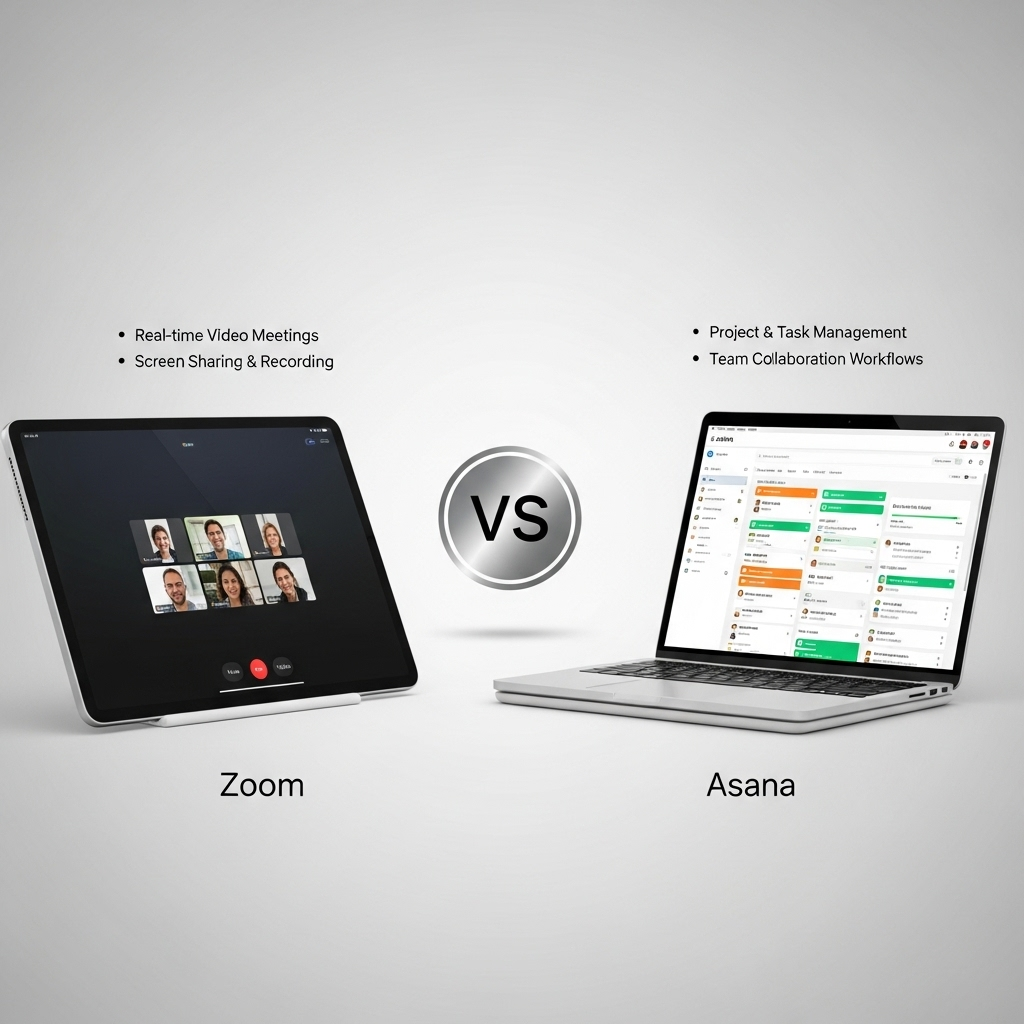Productivity software: Zoom vs. Asana
Quick Verdict
Zoom is better suited for video conferencing needs, while Asana is better for project management, but both offer valuable collaboration features and integrations.
- Zoom excels in video conferencing quality and features, while Asana focuses on project management and task tracking.
- Both platforms offer integrations with popular collaboration tools.
- Zoom's free plan has limitations, while Asana's free plan has a user limit.

Key features – Side-by-Side
| Attribute | Zoom | Asana |
|---|---|---|
| Video conferencing quality | High-quality video, average VMAF score of 73.2, GPU offloading, HD video option (Pro, Business, Education, or Enterprise account required). | Not available |
| Meeting scheduling features | Integrates with Google Calendar, Microsoft Outlook, and Apple Calendar. | Can be used for meeting scheduling by creating tasks and sub-tasks with assigned dates and times. Integrates with Google Calendar. |
| Screen sharing capabilities | Host and attendees can share screens, multiple participants can share simultaneously, options to share entire desktop, specific applications, a portion of screen, content from a second camera, or a whiteboard. | Not available |
| Collaboration tools integration | Integrates with Google Workspace, Slack, Microsoft Teams, Dropbox Spaces, Monday.com, and Asana. | Integrates with Slack, Google Drive, Microsoft Teams, and Dropbox to facilitate file sharing, communication, and real-time updates. |
| Project management features | Integrates with Hive, Asana and Monday.com. | Offers task assignments, progress tracking, timelines, and multiple project views (list, board, calendar, timeline). Allows for the organization of tasks into projects with customizable sections. |
| Workflow automation | Workflow Automation feature allows users to automate routine processes within Zoom Workplace. Users can design workflows ranging from simple sequences to more advanced automations with conditional logic. | Provides workflow automation features to automate repetitive tasks like assigning tasks, setting due dates, and sending notifications. Workflow Builder helps to create automated processes. |
| Reporting and analytics | Meeting and webinar statistics, lists of meeting participants, meeting statistics, user activity reports, analytics dashboards for meetings, phone, chat, and rooms. | Offers reporting and analytics features, including dashboards, charts, and graphs, to track project progress and team performance. |
| User interface and ease of use | Simple interface and usability, clean and uncluttered look, intuitive design. | Has an intuitive user interface, making it easy for beginners to learn. Some users feel the platform can be complicated to set up initially and the interface can become cluttered with too many tasks. |
| Mobile app availability and functionality | Mobile apps for iOS and Android devices. | Offers mobile apps for iOS and Android devices, allowing users to plan their day, share ideas, and get team updates on the go. The mobile app is considered reliable. |
Overall Comparison
Video: Zoom wins; Project Management: Asana wins; Collaboration: Both offer integrations
Pros and Cons
Zoom
Pros:
- High-quality video
- Integrates with calendar applications
- Screen sharing capabilities
- Integrates with collaboration tools
- Integrates with project management tools
- Workflow Automation feature
- Reporting and analytics tools
- Simple and intuitive interface
- Mobile apps available
- Integrates seamlessly with productivity tools like Google Calendar, Microsoft Outlook, Slack, and Microsoft Teams
- Offers virtual meeting features like breakout rooms, polling, and whiteboarding
- Employs security measures, including encryption, waiting rooms, passcodes, and screen share watermarks
Cons:
- Basic plan has a 40-minute time limit on group meetings
- Basic plan has a participant limit of 100 users
- Basic plan restricts access to certain features, such as language interpretation and cloud recording
- Responsiveness and helpfulness of customer support: Not available
- Mobile app performance compared to the desktop version: Not available
Asana
Pros:
- Intuitive user interface
- Flexible customization with custom fields, templates, and multiple project views
- Highly suitable for remote teams, offering features like task assignments, real-time updates, and communication tools
- Integrates with Google Calendar and Outlook
- Offers mobile apps for iOS and Android devices
Cons:
- Can be complicated to set up initially
- Interface can become cluttered with too many tasks
- Conflicting reviews of customer support
- Free plan has limitations on the number of users (10) and lacks advanced features like custom fields, timeline views, and advanced reporting
User Experiences and Feedback
Zoom
What Users Love
- Generally delivers the best overall experience, including video quality, even under network strain.
- Interface is relatively simple and intuitive.
- Designed to be easy to use, even for people who are not familiar with video conferencing software.
- Integrations streamline workflows and make it easier to schedule, join, and manage meetings.
- Offers a range of virtual meeting features, such as breakout rooms, polling, and whiteboarding, that enable remote teams to conduct interactive and engaging meetings.
- Screen sharing, chat, and file sharing enhance collaboration and facilitate effective communication.
Common Complaints
- A stable, high-speed internet connection is essential for high-quality Zoom video.
- Information on the specific responsiveness and helpfulness of Zoom's customer support team was not found in the provided search results.
- Information on the specific performance of the Zoom mobile app compared to the desktop version was not found in the provided search results.
Value Perception
- Integrates with project management tools like Asana and Monday.com.
- Workflow Automation feature allows users to automate routine processes and create custom workflows.
- Provides reporting and analytics tools that allow account owners and admins to track key usage and performance information.
- Employs several security measures, including encryption, waiting rooms, passcodes, and screen share watermarks.
- Communications are established using TLS, and meeting content is encrypted using 256-bit Advanced Encryption Standard (AES).
Asana
What Users Love
- No highlights reported.
Common Complaints
- No major complaints reported.
Value Perception
- No value feedback reported.